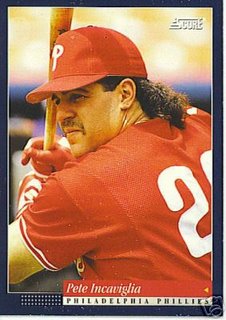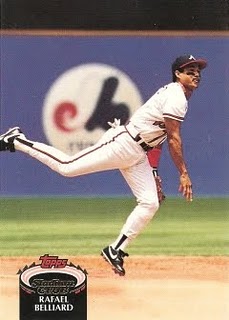Getting ready to do what he does worst.
Why we like him: You have to love it when a player understands exactly what his job is and does it without complaint or a desire for attention. From 1988 to 1990, the Oakland Athletics were the poster boys for the increasingly popular (and highly dubious, in retrospect) playing style of gearing your entire offensive game around the home run. By employing mashers like Jose Canseco, Mark McGwire, Dave Henderson, and Dave Parker, the A's were piling up runs with an almost cocky pizazz, blasting homer after homer during their three year run of World Series appearances. What they forgot, however, were the little things.
Despite being a career .239 hitter with just 42 homers over the course of his 13-year career, Mike Gallego was a key piece to A's championship puzzle. On a team that was built solely around slugging percentage, the A's were obviously lacking defensively. While terrifying hitters to face at the plate, Canseco and McGwire were each essentially a klutz in the field. Someone had to pick up their slack and make plays. Gallego had a career fielding percentage of .977 and put up a sparkling .986 while patrolling second base.
The other aspect of Gallego's game that warrants some serious merit was his ability to handle the bat in situational opportunities. He could almost always lay down a good bunt, hit a grounder to right side of the infield, or just find a way to move a baserunner. He never led the league in anything except sacrifice hits in 1990 with 17. That's the tell-tale sign of a guy who wants his team to win. And they did, at least until they ran into the Reds in the World Series that year.
Mike Gallego's career was about as ultimately meaningless as they come. By they end of his career, he'd been shipped off to the Bronx and again to St. Louis after a short second stint with Oakland, and he was nothing more than a defensive substitute or platoon infielder. However, just because a guy doesn't put up numbers does not mean he isn't appreciated.
Ladies and gentlemen, Mike Gallego, Ballplayer.
















